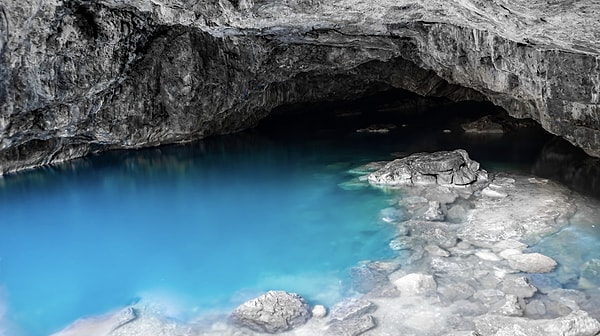Zeus Cave Travel Guide: Discover the Mythical Natural Wonder of Aydin, Turkey
Attracting attention with its fascinating atmosphere and mysterious past, Zeus Cave, located within the borders of Dilek Peninsula National Park in Kuşadası, is a must-see for both nature lovers and mythology enthusiasts. It manages to fascinate its visitors not only with its natural beauty but also with its deep ties to ancient Greek mythology. If you have travelled to Aydın province or around Kuşadası, you should not return without visiting this cave.
Geographical Location and Natural Structure of Zeus Cave

Zeus Cave is located within the borders of Güzelçamlı town of Aydın, just to the right of the entrance to Dilek Peninsula-Büyük Menderes Delta National Park. This cave in the rocky and forested areas contains a natural fresh water pond formed by underground water seeping from the rocks. However, some sources state that the water is semi-salty due to the mixing of sea water into the cave.
Its cool water, which remains constant throughout the year, offers a unique experience for those who want to cool off, especially in summer. The inside of the cave is about 10-15 meters long and has a swimmable depth. This pond, which looks calm and peaceful from the outside, harbours a dark and mysterious world underneath.
A Mythological Background: The Escape of Zeus

There is a mythological belief that Zeus hid here. According to ancient Greek mythology, Zeus, the god of the sky, took refuge in this cave to escape the anger of his brother Poseidon. Poseidon was angry at Zeus for switching sides during the Trojan War, and to appease his anger, he stirred up the Aegean Sea with waves. Zeus escaped from this chaos and took refuge in this mysterious cave, where he found peace.
According to another rumour, Zeus met with the nymphs and had a pleasant time here. Therefore, the cave is not only a place of escape but also a place of divine meeting and peace. This mythological connection makes the cave more than just a natural formation and gives it a soul.
Historical and Archaeological Importance

The Cave of Zeus has not been directly excavated or archaeologically excavated; however, the region where it is located has been home to many civilisations since ancient times. Ancient cities such as Priene, Miletus and Didim, which are very close to the cave, reveal how deep-rooted the region has a historical past.
In addition, the interior of the Dilek Peninsula has been the interaction area of Ionia and Lydia cultures throughout history. Therefore, the history of the cave is not only related to natural processes, but also culturally, mythologically and historically.
Transportation to Zeus Cave

Zeus Cave is very easy to reach. Kuşadası district of Aydın province is one of the biggest tourist centres of the region.
You can take minibuses from the centre of Kuşadası to Güzelçamlı (about a 30-minute journey) or by private car.
After parking your car at the entrance of Dilek Peninsula National Park, you can reach the cave by following the pathway on the right side of the entrance and walking about 50-60 meters.
Since the path is flat and short, visitors of all ages can easily walk. However, it is recommended to be careful in rocky areas; it is useful to wear suitable shoes.
What to do in the cave?

Zeus Cave is a small but fascinating getaway. The main activities that can be done here are as follows:
Swimming: Swimming in the cool waters of the cave is very popular, especially during the summer months. The water can be very cold, so be prepared.
Photography: The natural play of light and the clear water inside the cave are ideal for photographers who want to capture impressive shots.
Nature Observation: The surroundings of the cave attract attention with their rich vegetation and bird species. As it is a national park area, you are in a protected ecosystem.
Those who want to swim should be careful because the cave water may be deeper than expected and the undercurrents may occasionally force swimmers.
The Best Time to Visit
Zeus Cave is open to visitors at all times of the year, but the ideal period is spring and summer. While the surrounding nature comes alive in spring, the cool waters attract visitors in summer. However, it should not be forgotten that it can be crowded in the summer months. Visiting early in the morning or on weekdays offers a calmer experience.
Places to Visit

For those who visit Zeus Cave, there are many places to explore in the vicinity:
Dilek Peninsula-Büyük Menderes Delta National Park: One of Turkey's most impressive national parks with its magnificent bays, hiking trails and wildlife.
Guzelcamli Beach: Ideal for swimming and coastal walks.
Kurşunlu Monastery: A historical structure built on one of the hills in the national park, intertwined with nature.
Kavaklıburun, Aydınlık, Karasu and İçmeler Bays: These bays within the national park attract attention with their clean sea.
Priene Ancient City: It is about 30 minutes away from Zeus Cave. It is worth seeing with its impressive structures from the Hellenistic period.
Tips for Visitors
Be sure to bring sea shoes and a towel.
Visiting in the morning allows you to better experience the calmness of the cave.
Swimming in the cave for a long time can be difficult; maintain your body temperature.
There are picnic areas in the national park; you can turn your visit into a pleasant day trip.
Take your garbage with you to keep the environment clean and protect the natural structure.
Keşfet ile ziyaret ettiğin tüm kategorileri tek akışta gör!

Send Comment